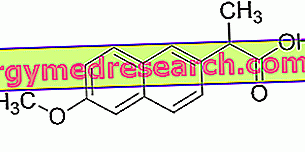Generality
Naproxen (or naproxen) is a non-steroidal anti-inflammatory drug (NSAID) with analgesic, antipyretic and anti-inflammatory activity.
Naproxen is available in different pharmaceutical formulations suitable for oral, rectal, parenteral and cutaneous administration.

Naproxen - Chemical Structure
From the chemical point of view, naproxen is a derivative of propionic acid.
Examples of medicinal specialties containing Naproxen
- Momendol ®
- Synflex ®
- Xenar ®
Indications
For what it uses
The use of naproxen is indicated for the symptomatic treatment of:
- Disorders of the musculoskeletal system (rheumatoid arthritis, osteoarthritis, ankylosing spondylitis, lumbosciatica, myalgia, etc.);
- Gout;
- Headache;
- Toothache;
- Menstrual cramps;
- Feverish states;
- Post-operative pain.
Warnings
Naproxen can cause allergic reactions, even very serious ones, in sensitive individuals. Therefore, should any allergic reaction appear during therapy with naproxen, treatment with the drug should be stopped immediately and the doctor should be informed immediately.
A lot of caution should be used when administering naproxen in patients with hypertension and / or heart failure.
Naproxen may cause gastrointestinal ulceration, perforation and / or bleeding. Therefore, in case of gastrointestinal symptoms it is good to inform the doctor immediately.
Elderly patients and patients who have suffered from severe gastrointestinal disorders in the past have a higher risk of developing the above adverse reactions.
Since naproxen may adversely affect female fertility, the drug should not be taken by women who intend to become pregnant.
Naproxen may increase the risk of heart attack and stroke, especially when used at high doses and for long periods. This is why it is essential never to take larger doses of medication than those recommended.
Naproxen administered orally, rectally or parenterally may cause undesirable effects that can alter the ability to drive and / or use machinery, so great care should be taken.
Interactions
The concomitant use of naproxen and ciclosporin (an immunosuppressant drug) may cause an increase in the plasma concentration of the latter, thereby increasing its toxicity, especially at the renal level.
Naproxen is also able to increase plasma concentration - hence toxicity - of methotrexate (an anticancer agent) and lithium salts (used in the therapy of bipolar disorder).
Also, before starting treatment with naproxen, you must tell your doctor if you are already taking any of the following medications:
- Other NSAIDs, corticosteroids, platelet aggregation inhibitors and SSRIs (selective serotonin reuptake inhibitors), as there is an increased risk of developing gastrointestinal bleeding;
- Anticoagulants, since naproxen increases their effects;
- Antihypertensive drugs (diuretics, ACE inhibitors, angiotensin II antagonists), since naproxen reduces their efficacy and causes a deterioration in patients with impaired pre-existing renal function;
- Quinolones (antibiotic drugs);
- Contraceptives, since naproxen can decrease its effectiveness;
- Probenecid, as naproxen increases its plasma concentration.
In any case, it is still advisable to inform your doctor if you are taking - or have recently been - any type of medication, including prescription-free medicines and herbal and homeopathic products.
Side effects
Naproxen can cause different types of side effects, although not all patients experience them. The type of side effects and the intensity with which they occur depend on each individual's sensitivity to the drug.
The following are the main adverse effects that can occur during treatment with naproxen.
Gastrointestinal disorders
During the course of naproxen therapy, the following can occur:
- Nausea;
- He retched;
- Hematemesis;
- Dyspepsia;
- Abdominal pain;
- Diarrhea or constipation;
- Melena;
- Gastrointestinal ulceration, perforation and / or bleeding.
Blood and lymphatic system disorders
Treatment with naproxen may cause:
- Aplastic anemia;
- Hemolytic anemia;
- Leukopenia;
- agranulocytosis;
- eosinophilia;
- Thrombocytopenia.
Nervous system disorders
Naproxen therapy can cause dizziness, headache, dizziness, drowsiness, cognitive disorders, convulsions and aseptic meningitis.
Psychiatric disorders
The treatment with naproxen can promote the onset of insomnia, sleep disorders, depression and difficulty concentrating.
Cardiovascular disorders
During the course of naproxen therapy, the following can occur:
- vasculitis;
- Tachycardia;
- Heart failure;
- Hypertension;
- Palpitations.
Other side effects
Other side effects that may occur during treatment with naproxen are:
- Allergic reactions, even serious, in sensitive individuals;
- Angioedema;
- Rash, itching and hives;
- Hepatitis and jaundice;
- Dyspnea, asthma, alveolitis or eosinophilic pneumonia;
- Hyperglycemia or hypoglycemia;
- Impaired renal function and glomerulonephritis;
- Myalgia and / or muscle weakness;
- Edema;
- Malaise;
- Increased thirst;
- hyperkalemia;
- Increased blood creatinine levels.
Side effects related to dermal administration of naproxen
Following the use of the naproxen-based gel or cream, the following can occur:
- Redness, itching and / or irritation of the skin;
- Sensations of heat and / or burning;
- Rash at the application site;
- Photosensitivity reactions.
Overdose
At present, no cases of overdose are known following the use of naproxen via the skin.
On the other hand, if overdoses of naproxen are taken orally, rectally or parenterally, the following may occur:
- Nausea;
- He retched;
- Abdominal disorders;
- Numbness;
- dizziness;
- Changes in hepatic and renal function;
- Shortness of breath;
- Disorientation;
- Gastrointestinal bleeding.
If you suspect a naproxen overdose, you must contact your doctor immediately and go to the nearest hospital.
Action mechanism
Naproxen exerts its antipyretic, analgesic and anti-inflammatory action by inhibiting cyclooxygenase (or COX).
Cyclooxygenase is an enzyme of which three different isoforms are known: COX-1, COX-2 and COX-3.
COX-1 is a constitutive isoform, normally present in cells and involved in the mechanisms of cellular homeostasis.
COX-2, on the other hand, is an inducible isoform that is produced by inflammatory cells (inflammatory cytokines) activated. The task of these enzymes is to convert arachidonic acid into prostaglandins, prostacyclines and thromboxanes.
Prostaglandins - and in particular, prostaglandins G2 and H2 - are involved in inflammatory and painful processes, while prostaglandins E are involved in the mechanisms of rise in body temperature (fever).
Naproxen, therefore, through the inhibition of COX-2 prevents the formation of prostaglandins responsible for fever, pain and inflammation.
However, it should be pointed out that naproxen is not a selective COX-2 inhibitor, therefore, it is also able to inhibit COX-1. This latter inhibition is at the origin of some of the side effects typical of all non-selective NSAIDs.
Mode of Use - Posology
Naproxen is available for:
- Oral administration in the form of tablets, hard capsules and granules for oral solution.
- Rectal administration in the form of suppositories.
- Parenteral administration as an injectable solution for intramuscular use.
- Dermal administration in the form of gel or cream.
During treatment with the drug, it is very important to follow the doctor's instructions carefully, both as regards the amount of drug to be taken and the duration of the treatment itself.
However, some indications are given below on the doses of naproxen usually used in therapy.
Oral and rectal administration
When administered orally or rectally, the usual dose of naproxen is 500-1000 mg per day, to be taken in divided doses every 8-12 hours.
Parenteral administration
In this case, the dose of naproxen usually used is 550 mg, to be administered every 12 hours intramuscularly.
Cutaneous administration
When using naproxen-based gel or cream, it is recommended to perform two applications a day directly in the affected area, massaging until completely absorbed.
Pregnancy and breastfeeding
Generally, the use of naproxen is not recommended during the first and second trimester of pregnancy, except in the case in which the doctor does not consider it absolutely necessary.
The use of the drug during the third trimester of gestation, however, is contraindicated, due to the serious damage that the drug can cause to the fetus and the mother.
Furthermore, the use of naproxen is also contraindicated in breastfeeding mothers.
Contraindications
The use of naproxen by oral, rectal and parenteral route is contraindicated in the following cases:
- In patients with hypersensitivity known to the same naproxen (even when using naproxen via the skin);
- In patients who have suffered from asthma following the administration of acetylsalicylic acid, analgesic-antipyretics or other NSAIDs;
- In patients with severe heart failure or severe renal failure;
- In patients with liver cirrhosis or hepatitis;
- In patients undergoing intensive therapy with diuretic drugs;
- In patients who suffer - or who have suffered - from ulcer, perforation and / or gastrointestinal bleeding;
- In patients with bleeding in place or with a predisposition to bleeding;
- In patients already on anticoagulant therapy;
- In children and adolescents under 16 years of age;
- In the last trimester of pregnancy (even when using naproxen via the skin);
- During lactation (even when using naproxen via the skin).



